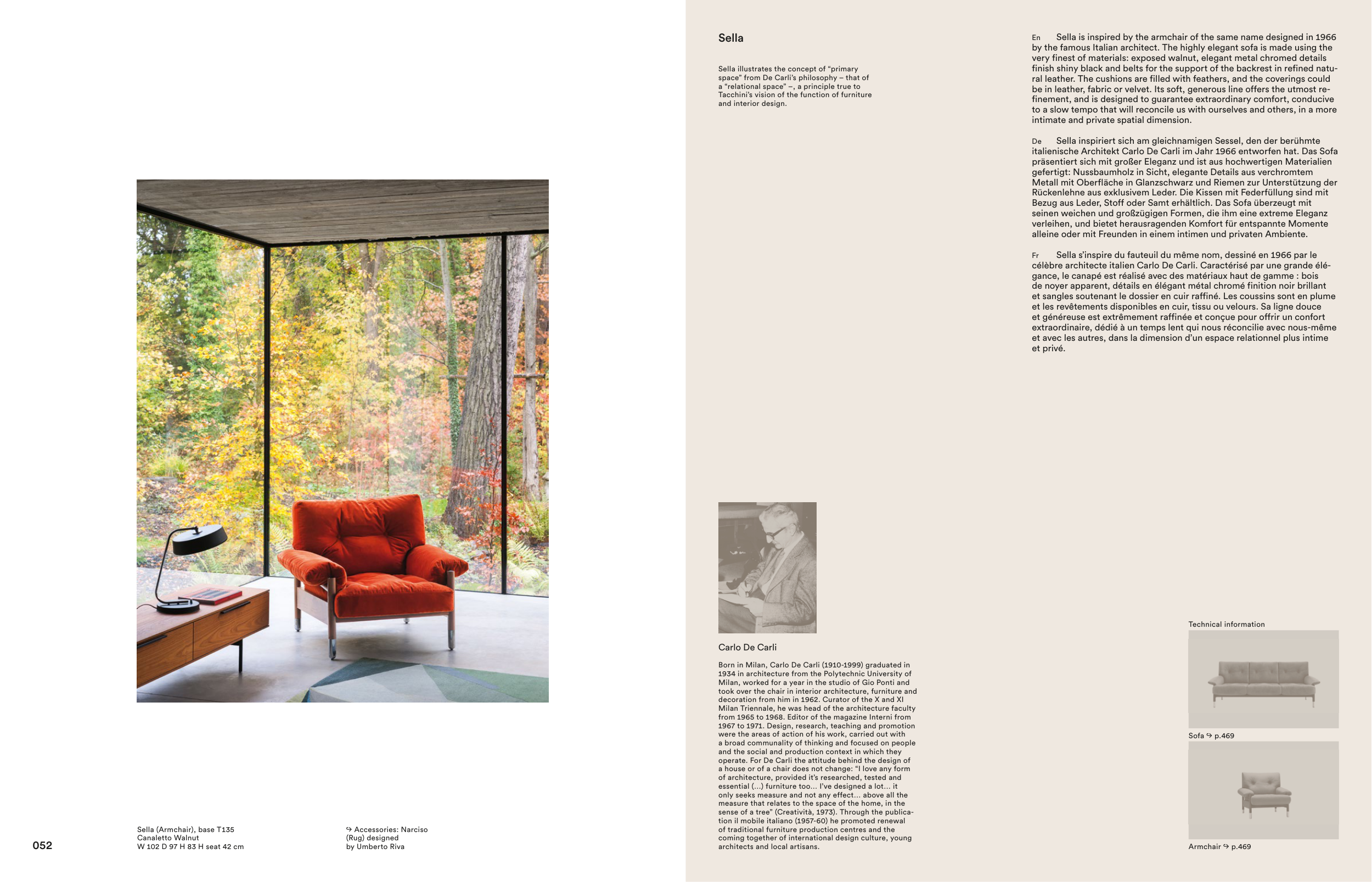En
Sella is inspired by the armchair of the same name designed in 1966
by the famous Italian architect. The highly elegant sofa is made using the
very finest of materials: exposed walnut, elegant metal chromed details
finish shiny black and belts for the support of the backrest in refined natu-
ral leather. The cushions are filled with feathers, and the coverings could
be in leather, fabric or velvet. Its soft, generous line offers the utmost re-
finement, and is designed to guarantee extraordinary comfort, conducive
to a slow tempo that will reconcile us with ourselves and others, in a more
intimate and private spatial dimension.
De
Sella inspiriert sich am gleichnamigen Sessel, den der berühmte
italienische Architekt Carlo De Carli im Jahr 1966 entworfen hat. Das Sofa
präsentiert sich mit großer Eleganz und ist aus hochwertigen Materialien
gefertigt: Nussbaumholz in Sicht, elegante Details aus verchromtem
Metall mit Oberfläche in Glanzschwarz und Riemen zur Unterstützung der
Rückenlehne aus exklusivem Leder. Die Kissen mit Federfüllung sind mit
Bezug aus Leder, Stoff oder Samt erhältlich. Das Sofa überzeugt mit
seinen weichen und großzügigen Formen, die ihm eine extreme Eleganz
verleihen, und bietet herausragenden Komfort für entspannte Momente
alleine oder mit Freunden in einem intimen und privaten Ambiente.
Fr
Sella s’inspire du fauteuil du même nom, dessiné en 1966 par le
célèbre architecte italien Carlo De Carli. Caractérisé par une grande élé-
gance, le canapé est réalisé avec des matériaux haut de gamme : bois
de noyer apparent, détails en élégant métal chromé finition noir brillant
et sangles soutenant le dossier en cuir raffiné. Les coussins sont en plume
et les revêtements disponibles en cuir, tissu ou velours. Sa ligne douce
et généreuse est extrêmement raffinée et conçue pour offrir un confort
extraordinaire, dédié à un temps lent qui nous réconcilie avec nous-même
et avec les autres, dans la dimension d’un espace relationnel plus intime
et privé.
Carlo De Carli
Born in Milan, Carlo De Carli (1910-1999) graduated in
1934 in architecture from the Polytechnic University of
Milan, worked for a year in the studio of Gio Ponti and
took over the chair in interior architecture, furniture and
decoration from him in 1962. Curator of the X and XI
Milan Triennale, he was head of the architecture faculty
from 1965 to 1968. Editor of the magazine Interni from
1967 to 1971. Design, research, teaching and promotion
were the areas of action of his work, carried out with
a broad communality of thinking and focused on people
and the social and production context in which they
operate. For De Carli the attitude behind the design of
a house or of a chair does not change: “I love any form
of architecture, provided it’s researched, tested and
essential (…) furniture too… I’ve designed a lot… it
only seeks measure and not any effect… above all the
measure that relates to the space of the home, in the
sense of a tree” (Creatività, 1973). Through the publica-
tion il mobile italiano (1957-60) he promoted renewal
of traditional furniture production centres and the
coming together of international design culture, young
architects and local artisans.
Armchair ↪ p.469
Sofa ↪ p.469
Technical information
Sella
Sella illustrates the concept of “primary
space” from De Carli’s philosophy – that of
a “relational space” –, a principle true to
Tacchini’s vision of the function of furniture
and interior design.
Sella (Armchair), base T135
Canaletto Walnut
W 102 D 97 H 83 H seat 42 cm
↪ Accessories: Narciso
(Rug) designed
by Umberto Riva
052


